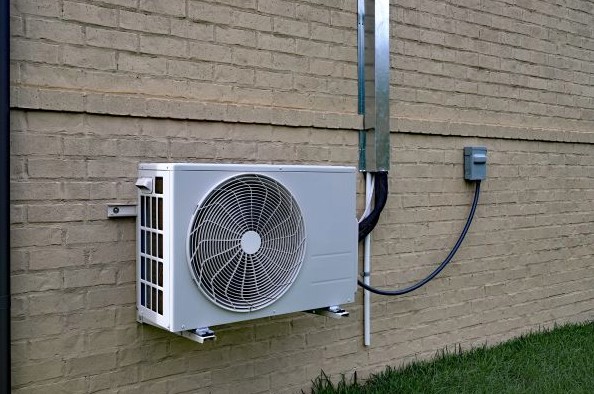Your ductless split system has kept you warm all winter, providing an energy-efficient source of heating that could be targeted toward specific areas of your home. Now, with summer approaching, it will once again be time to switch on this unique and revolutionary technology: this time, to keep you and your family cool during the hottest days of the year.
Before the mercury starts to rise, however, it’s important to take some time to keep each part of your ductless split system in good working order. This will help ensure optimal cooling performance during the hot months, as well as reduce the risk of the system breaking down when you need it most. In the following blog post, we’ll offer some expert tips to get your ductless split cooling system ready for summer.
What Is a Ductless Split System?
Ductless split systems are a unique method of heating and cooling buildings. They are referred to as “split” systems because they are composed of two elements: an outdoor condenser unit, which makes use of refrigerant coils to draw heat from the surrounding air, and an indoor fan unit, which vents the air into a room.
Unlike traditional HVAC systems, which utilize a large central system and a network of ducts to circulate air all throughout a building, ductless split systems are smaller. Each unit is constructed to address only one area (referred to as an HVAC zone), and multiple units may be required to cool a larger space or multiple rooms.
Ductless split systems are more efficient than traditional HVAC systems, but their true advantage lies in the fact that they are capable of performing both heating and cooling. The condenser coils on the outside element of the system can either draw ambient heat from the outside atmosphere and vent it inside the building, serving as a heater, or the process can be reversed, and the system can draw heat energy from the indoor air and vent it to the outside, thus acting as an air conditioner.
Making the Switch from Heating to Cooling
Since your ductless split system can be used for both heating and cooling, it will be working hard all year to keep your home at a comfortable temperature. The principle behind the heating setting versus the cooling one is the same. The only difference is where the heat energy is drawn from and where it’s vented.
With most systems, you won’t necessarily even need to do anything to switch them from heating mode to cooling as the weather begins to warm up. You’ll simply keep them on the AUTO setting and punch in your preferred temperature. The system will do the rest, changing settings depending on the need.
Of course, this can also be done manually. Ductless mini-split systems typically come with a remote control or smart technology, which you can use to change any of the settings as necessary. Simply press the MODE button to switch from AUTO to the COOL or HEAT setting. You can also turn off the temperature controls and simply use the unit as a dehumidifier.
Inspecting Your System Before the Summer
While the switch from heating to cooling is easy, ensuring the system is ready for summer requires a little more preparation. Regular maintenance and care are necessary to ensure the system is operating at peak capacity and at maximum energy efficiency. Forgoing this maintenance could lead to a higher monthly bill as a result of increased energy consumption. It can also put your system at risk of failure just when you need it most.
Winter weather combined with heavy use can strain your HVAC system. That’s why you should inspect it—or, better yet, have a professional perform an inspection—before the summer arrives. Inspections should check everything, including electrical elements, evaporator coils, and the ventilation system itself. It’s also critical to ensure your thermostat is in good working order, as malfunctions or poor electrical connections can cause the system to be inefficient or fail completely.
Cleaning the Coils
Whether it’s being used for heating or cooling, your ductless mini-split system uses condenser coils to draw heat from the air. If these coils are dirty or otherwise compromised, which can often happen in winter weather, the system simply won’t transfer the heat energy as effectively or efficiently.
During your inspection, if you notice any buildup of dirt or grime on the coils, you’ll need to clean it off. Specialty coil cleaner can be purchased to do the job. Apply this to a cloth and wipe the coils down to keep them in peak condition.
Refrigerant levels may need to be topped off if they have fallen off during the winter. Typically, refrigerant should only be handled by a certified professional, so contact your HVAC technician for this service.
Optimizing Airflow
To ensure maximum efficiency from your ductless split system, you must ensure the airflow isn’t blocked in any way. Frequently, these systems lose efficiency when tree branches or other obstructions block air to the outdoor unit. Before the weather begins to warm up, trim away any plant growth that has come within a few feet of the condenser unit. Keeping the surrounding area clean will allow the unit to effectively vent heat out of the building.
Replacing or Cleaning the Filters
Since these types of systems draw outdoor air into the home, they are equipped with filters to catch pollutants and allergens. It’s likely that, during the winter, when the system was pulling overtime as a heating unit, these filters became dirty and clogged with dust, dirt, and pollen. Replace or clean the filters before summer to prevent the inefficiency that leads to increased energy costs.
Maintaining Your Ductless Mini-Split Year Round
No matter what time of year it is, regular maintenance is a must to ensure your ductless mini-split works at optimal capacity year after year. Ideally, you should have your system checked by a professional at least once a year.
At All Weather Heating & Cooling, our HVAC technicians can perform the maintenance you need to increase the longevity of your system and reduce your energy costs during the summer, winter, and throughout the year.

